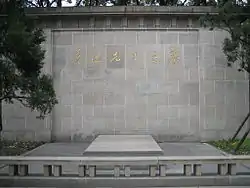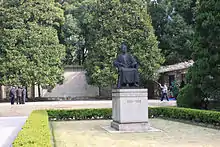| Tomb of Luxun | |
|---|---|
 The tomb of Lu Xun | |
| Location | Lu Xun Park, Shanghai, China |
| Coordinates | 31°16′27″N 121°28′41″E / 31.27414°N 121.478062°E |
| Built | 1956 |
| Owner | Lu Xun |

The tomb of Lu Xun is the burial place of the Chinese writer Lu Xun (1881–1936), located in the northwestern corner of the Lu Xun Park in Hongkou District, Shanghai. Covering an area of 1,600 square metres (17,000 sq ft), the tomb of Lu Xun was built in 1956, and in the same year, the remains of Lu Xun was moved to this tomb from the Wanguo Cemetery of Shanghai.
The tomb of Lu Xun was listed as the first batch of the major historical and cultural site protected at the national level, by the State Council of the People's Republic of China, on 4 March 1961.
History
Modern
Lu Xun was the pen name of Zhou Shuren.[1] Born and raised in Shaoxing, Zhejiang,[2] he was a leading figure of modern Chinese literature and the New Culture Movement.[3][4] He died in his Shanghai apartment on 19 October 1936 and was buried in the grave numbered 406 - 413, F section, East side of the Wanguo public cemetery of Shanghai.[5] There were just several mounds on the former grave of Lu Xun. Until 1937, a 71.2-centimeter-high and 31.5-centimeter-wide trapezoidal cement gravestone was erected on the north side of the mounds, embedded with a 38-centimeter-high and 25-centimeter-wide pottery sculpture of Lu Xun and with characters "the grave of Lu Xun" written by Zhou Haiying, the son of Lu Xun.[6]: 32 [note 1] During the Second Sino-Japanese War (1937-1945), the Wanguo public cemetery was unattended. The wintergreen grew beside the grave was removed and the gravestone was slightly damaged which was repaired by Kanzō Uchiyama, a close friend of Lu Xun. In the year of 1939, the grave of Lu Xun was a total loss, with the pottery sculpture of Lu Xun on the gravestone was destroyed purposely. After the end of the war, a new form of the gravestone was designed by Xu Guangping, the widow of Lu Xun.[8] In October 1946, with approximately 2000 participants, the 10th anniversary of the death of Lu Xun was held in Shanghai, organized by the National Resistance Association of Literary and Art Works (Zhonghua Quanguo Wenyijie Kangdi Xiehui). In the next day, about 300 people from all walks of life visited the grave of Lu Xun, and two cypress trees were planted by Zhou Enlai and Xu Guangping, in the front part of the grave. [6]: 34 In 1947, the surface of the grave was renovated, replaced the old gravestone with a new one and relocated the old one on the right front side of the grave horizontally. The new gravestone was made out of granite and was 97 centimeters in height and 87 centimeters in width, and was embedded with a 66-centimeter-high and 60-centimeter-wide black stone stele on it. There was a portrait of Lu Xun in a shape of oblong on the stele, and a gold inscription "the grave of Lu Xun, born on the 25th of September, 1881 in Shaoxing and died on the 19th of October, 1936, in Shanghai" was engraved under the portrait, written by Zhou Jianren (the younger brother of Lu Xun).[8] Apart from a new gravestone, a new three-level granite step was built on the south side of the grave, with three memorial stone vases placed on the steps.[6]: 39
Contemporary
In the spring of 1952, after the discussion among the cultural department of East China and other relevant departments, a proposal of building a new tomb of Lu Xun in the Hongkou park, previously visited by Lu Xun and near the former residence of him, was accepted.[9] In January 1956, the 20th anniversary of the death of Lu Xun, a decision of moving the grave of Lu Xun from the public cemetery of Shanghai to the Hongkou park was made by the State Council of the People's Republic of China. With members of Lu Xun's relatives, friends and some officials of East China and Shanghai, a committee of moving the grave was formed by Chen Yi, the mayor of Shanghai at that time.[10] The new tomb was located in the Hongkou Park.[note 2] In June 1956, several experts were hired by the government of Shanghai to design the new tomb and the Memorial of Lu Xun. Assessed by the State Council of the People's Republic of China, the plan of Chen Zhi and Wang Dingzeng was adopted, and Chen Zhi was in charge of the design of the new tomb of Lu Xun, which constructed on the 19th of July 1956 and finished on the 9th of October 1956.[12] On 14 October 1956, the ceremony of moving the coffin of Lu Xun[note 3]from Shanghai public cemetery to the new tomb was held by the government of Shanghai. The inscription of the new tomb was written by Mao Zedong: 鲁迅先生之墓 [The Tomb of Mr. Lu Xun], and the former grave was preserved at the same time.[8] The new tomb was opened to the public on the 25th of October.[12] On the 4th of March 1961, a stone monument with signs of the major historical and cultural site protected at the national level was placed in front of the tomb.[6]: 46 In July 1964, with the approval of the cultural department, the protection area of the tomb was finalized.[14] In 1966, during the Cultural Revolution, the former grave of Lu Xun and other graves nearby were all demolished and changed into a place to store industrial wastes. In 1973, two gravestones of the former grave were rediscovered.[8]
Notes
- ↑ 1. Zhou Haiying was just six years old at that time. This 6-character inscription was drafted by Xu Guangping and after repetitive practice, was written by Zhou Haiying on the gravestone.[7]
- ↑ 2. On 19 October 1988, after the approval of the 351st meeting of the standing committee of Shanghai, the Hongkou park was renamed as Lu Xun Park.[11]
- ↑ 3. When moving the grave, the coffin of Lu Xun showed signs of decaying, with faded paint, loose coffin lid, dripping water and a decayed flag image (the spirit of the nation) on the coffin, but the characters on the coffin were recognizable. Therefore, the coffin was strengthened and renovated with black paint. Besides, there was a suggestion of replacing the wooden coffin with a glass coffin, proposed by one staff. However, this suggestion was overruled.[13]
References
- ↑ "鲁迅诞辰133周年:借其收藏画作缅怀远去文豪" (in Chinese (China)). 网易艺术. 2014-09-25. Archived from the original on 2015-02-26. Retrieved 2015-02-09.
- ↑ "故乡之于鲁迅:认识国家与国民的起点" (in Chinese (China)). 新浪新闻. 2014-09-25. Archived from the original on 2015-02-26. Retrieved 2015-02-09.
- ↑ 张润泽 (2013). 鲁迅与新文化运动. 华章. 13.
- ↑ 任冠中 (February 2009). 鲁迅与五四新文化运动. 大众文艺. 13: 96–97.
- ↑ 马婕 (January 2011). 永远的民族魂——鲁迅墓迁移前前后后. 上海采风: 26–29.
- 1 2 3 4 郭凤珍; 朱嘉栋 (1982). 上海鲁迅故居·鲁迅墓. 北京: 文物出版社. p. 481.
- ↑ 贾关法 (February 1996). 鲁迅墓碑变迁记. 上海集邮: 11.
- 1 2 3 4 周海婴 (May 1986). 忆鲁迅墓的变迁. 鲁迅研究动态: 2–6.
- ↑ 上海市虹口区志·鲁迅在虹口·纪念地·鲁迅墓 (in Chinese (China)). 上海市地方志办公室. 2011-08-24. Archived from the original on 2015-02-26. Retrieved 2015-02-09.
- ↑ 朱嘉栋 (December 1986). 鲁迅墓记事. 鲁迅研究动态: 13–15.
- ↑ 上海园林志·公园·纪念性公园·鲁迅公园. 上海市地方志办公室 (in Chinese (China)). 2014-09-25. Archived from the original on 2015-02-25. Retrieved 2015-02-09.
- 1 2 娄承浩 (2013). 陈植:世纪人生. pp. 127–136. ISBN 978-7-5608-5008-5.
- ↑ 朱嘉栋 (June 1983). 关于鲁迅的棺材. 鲁迅研究动态: 22–23.
- ↑ 上海市虹口区志·文化·上海鲁迅纪念馆·纪念地·鲁迅文化研究·鲁迅墓. 上海市地方志办公室 (in Chinese (China)). 2011-08-24. Archived from the original on 2015-02-26. Retrieved 2015-02-09.